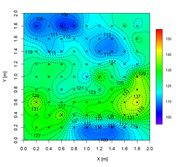Estimación de la variabilidad mecánica de placas de roca por ensayos no-destructivos: métodos de análisis
Main Article Content
Keywords
Geoestadística, modelo de señal, variabilidad mecánica, material rocoso, sodalita, martillo Schmidt-L
Resumen
En este artículo se emplean mayores y complementarios métodos de análisis para estimar la variabilidad mecánica de placas de material rocoso por ensayos no-destructivos, inicialmente presentado en esta misma revista. Esto con el propósito de generalizar y mejorar la aplicabilidad de este método alternativo, basado en la geoestadística, para que pueda ser utilizado en procesos de control de calidad de placas de material rocoso destinadas al revestimiento de pisos. Se ha hecho énfasis en los métodos de análisis geoestadísticos, en lo que respecta al análisis exploratorio de los datos, análisis de anisotropía, verificación del modelo geoestadístico, verificación de la estructura espacial, verificación del tamaño de muestra y modelación de la distribución espacial de la resistencia mecánica.
Descargas
Referencias
[2] P. R. Shorey, D. Barat, M. N. Das, K. P. Mukherjee, and B. Singh, “Schmidthammer rebound data for estimation of large scale in-situ coal strength,”International Journal of Rock Mechanics and Mining Sciences, no. 21, pp.39–42, 1984. 102
[3] K. Y. Haramy and M. J. DeMarco, “Use of Schmidt hammer for rock andcoal testing,” inProceedings of the 26th U.S. Symposium on Rock Mechanics,E. Ashworth, Ed., South Dakota School of Mines and Technology. RapidCity, SD: Balkema Rotterdam, 1985, pp. 549–555. 102
[4] A. K. Ghose and S. Chakraborti, “Empirical strength indices of Indian coals:An investigation,” inProceedings of the 27th U.S. Symposium on Rock Me-chanics: Key to energy production, H. Hartman, Ed., University of Alabama.H.L. Hartman: Balkema Rotterdam, 1986, pp. 59–61. 102
[5] O. Katz, Z. Reches, and J. C. Roegiers, “Evaluation of mechanical rock pro-perties using a Schmidt hammer,”International Journal of Rock Mechanicsand Mining Sciences, no. 37, pp. 723–728, 2000. 102
[6] I. S. Buyuksagis and R. M. Göktan, “The effect of Schmidt hammer type onuniaxial compressive strength prediction of rock,”International Journal ofRock Mechanics and Mining Sciences, no. 44, pp. 299–307, 2007. 102
[7] R. N. Singh, F. P. Hassani, and P. A. S. Elkington, “The application ofstrength and deformation index testing to the stability assessment of coalmeasures excavations,” inProceedings of the 24th U.S. Symposium on RockMechanics: Rock Mechanics Theory, Experiment, Practice, C. Mathewson,Ed., Association of Environmental and Engineering Geologists. CollegeStation, Texas: Texas A&M University Press, 1983, pp. 599–609. 102
[8] J. E. O’Rourke, “Rock index properties for geo-engineering in undergrounddevelopment,”Mining Engineering, pp. 106–110, 1989. 102
[9] C. I. Sachpazis, “Correlating Schmidt hardness with compressive strengthand Young’s modulus of carbonate rocks,”Bulletin of the International As-sociation of Engineering Geology, no. 42, pp. 75–83, 1990. 102, 103
[10] S. Xu, P. Grasso, and M. A. Mahtab, “Use of Schmid hammer for estimatingmechanical properties of weak rock,” inProceedings of the 6th InternationalAssociation for Engineering Geology Congress, D. Price, Ed., InternationalAssociation for Engineering Geology. Amsterdam, Netherlands: BalkemaRotterdam, 1990, pp. 511–519. 102
[11] G. Aggistalis, A. Alivizatos, D. Stamoulis, and G. Stournaras, “Correlatinguniaxial compressive strength with Schmidt hammer rebound number, pointload index, Young’s modulus, and mineralogy of gabbros and basalts (Nort-hern Greece),”Bulletin of the Association of Engineering Geologists, no. 54,pp. 3–11, 1996. 102
[12] I. Dincer, A. Acar, I. Cobanoglu, and Y. Uras, “Correlation between Schmidthardness uniaxial compressive strength and Young’s modulus for andesites-basalts and tuffs,”Bulletin of Engineering Geology and the Environment,no. 63, pp. 141–148, 2004. 102
[13] ISRM, “Suggested methods for the quantitative description of discontinui-ties in rock masses,”International Journal of Rock Mechanics and MiningSciences, vol. 6, no. 15, pp. 319–368, 1978. 102
[14] U. S. Bureau of Reclamation,Engineering Geology field manual: Field indextests, 1st ed. U.S. Bureau of Reclamation & U.S. Departtment of Interior,1998. 102
[15] ASTM D5873-05, “Test method for determination of rock hardness by re-bound hammer method,” ASTM International, Philadelphia, Technical re-port, 2005. 102
[16] V. Hucka, “A rapid method for determining the strength of rocks in situ,”International Journal of Rock Mechanics and Mining Sciences, no. 2, pp.127–134, 1965. 102
[17] R. M. Göktan and C. A. Ayday, “Suggested improvement to the Schmidtrebound hardness ISRM suggested method with particular reference to rockmachineability,”International Journal of Rock Mechanics and Mining Scien-ces, no. 30, pp. 321–322, 1993. 102
[18] L. O. Suarez-Burgoa, “Estimación de la variabilidad mecánica de placas deroca por ensayos no-destructivos,”Ingeniería y Ciencia, vol. 7, no. 14, pp.11–36, 2011. 103, 104, 105, 108, 112, 114
[19] N. A. C. Cressie,Statistics for spatial data. John Wiley and Sons, 1993. 105
[20] O. Schabenberger and F. J. Pierce,Contemporary statistical models for theplant and soil sciences. CRC Press, 2001. 105
[21] P. Diggle and P. J. Ribeiro,Model-based geostatistics. Springer New York,2007. 107, 111
[22] J.-P. Chiles and P. Delfiner,Geostatistics: Modeling spatial uncertainty. JohnWiley and Sons, 1999. 107
[23] X. Emery,Geoestadística. Universidad de Chile, 2013. 107

